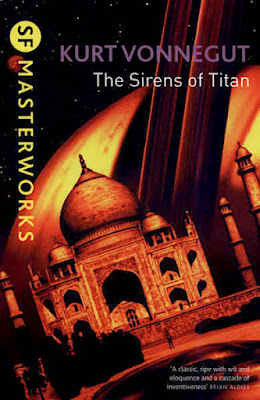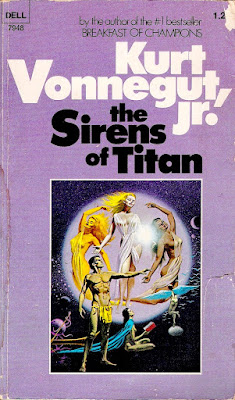NOT VONNEGUT’S
MOON OF SATURN
Book Review of:
‘THE SIRENS OF TITAN’
by KURT VONNEGUT JR
(Gollancz Classic SF, 1986, £2.95)
Vonnegut was a big dead. Lecture tours, interviews and full-spread feature reviews in the heavy’s Lit Sections – the full ‘serious contemporary writer’ scam. While this timely reissue was part of a process through which the Gollancz SF imprint was deluging itself in twenty-five-year anniversary self-congratulation, leaving the impartial reviewer conscience-bound to wonder whether the whole circus measures up. Whether perhaps – like the fourteenth volume of ‘The Book Of Bokonin’, these literary achievements don’t add up to the single word ‘nothing’?
‘The Sirens Of Titan’ – first unleashed in 1959, is a central dogma in the Vonnegut canon. Devotees will already know that it’s a veritable fountainhead of Vonnegutian profundity, breeding all manner of mythos-components and traceable in-references. Take one at random: ‘The Sirens Of Titan’ has the city of Ilium destroyed by a Martian invasion. The previous novel, ‘Player Piano’ (1952), was set in Ilium, a fictional eastern suburb of New York State. Literary critic Peter J Reed speculates that the Ilium preoccupation could derive from the great man’s period of employment at General Electric in Schenectady N.Y (in ‘Kurt Vonnegut Jr’ by Peter J Reed, Warner Paperback Library ‘Writers For The Seventies’ series), his contention is reinforced by the fact that General Electric becomes the first employers of Howard Campbell in Vonnegut’s later ‘Mother Night’ (1962). The Ilium Works also figure in a 1955 ‘Esquire’ short story “Deer In The Works”, a Kafkaesque exercise in which a prospective PR man becomes lost in the incomprehensible labyrinths of its industrial complex. Jonah in ‘Cat’s Cradle’ (1963) spends time in Ilium researching Dr Felix Hoenikker who worked most of his life there for the General Forge & Foundry Company and… there’s more! The central character from ‘Slaughterhouse Five’ (1969), Billy Pilgrim, passes through the city while returning from fire-bombed Dresden. It’s also perhaps worth noting that Ilium is Troy in Homeric legend.
Vonnegut’s novels contain a tangle of such tertiary threads. None of his characters are exact stereotypes or exactly predictable. None of his affirmations or condemnations are made without escape-clause qualifications. Hence attempted unravelment becomes an intoxicatingly addictive game. The American National Education TV Network took a sword to this symbolist Gordian Knot with a film, screened by BBC’s ‘Second House’ in February 1973. It used ‘The Sirens Of Titan’ central gimmick – the Chrono Synclastic Infundibula, as a focal point through which a jumbled juxtaposition of Vonnegut themes and ideas could be channelled. It’s an amusingly self-indulgent pastiche essay in which astronaut Stoney Stevenson is launched from Cape Kennedy into the Chrono Syn… etc – a CSI, to be vomited back at intervals into excerpts from Vonnegut’s various novels and short stories throughout the film’s seventy-five-minute duration. The central core of ‘The Sirens Of Titan’ is also fleshed out by encounters with Bokonin – ‘Cat’s Cradle’s Rastafarian-like oracle, and is entertaining while also being thought-provoking. George Roy Hill’s movie version of ‘Slaughterhouse Five’ (1972) does a similar meltdown job by transforming the planet Tralfamadore into a moon of Saturn – hence becoming Titan. An inaccurate, but intriguing bit of literary scene-shifting.
Is this getting too complicated?
Happily, a straight plot rundown of the novel provides little elucidation.
According to Peter J Reed the metamorphosed Paul (‘Player Piano’) Proteus becomes Malachi ‘Unk’ Constant; the basic Proteus archetype thus assumes the role of central protagonist of ‘The Sirens Of Titan’. To back up the assertion he points out that both characters feel vaguely dissatisfied with their lives. That, partly through resistance to manipulation by others, and partly out of loyalty to a friend, both undergo a considerable change of values. Both emerge somewhat battered, rather disillusioned but with some beliefs to affirm, and stronger more honest men. In ‘The Sirens Of Titan’ the resistance to manipulation of Reed’s speculation manifests itself through Constant’s loss of wealth. A deliberate attempt on his part to avoid a prediction made by Winston Rumfoord who is trapped, as ‘wave phenomenon’, in a kink in space-time (a CSI). Rumfoord materialises in the real universe at regular intervals. In much the same way that the selectively-bred Rumfoord dynasty turn up with a certain regularity throughout the Vonnegut mythos. The Rumfoord estate appears as an incidental location in ‘God Bless You Mr Rosewater’ (1965), Bertram Copeland and Lance Rumfoord both appear in ‘Slaughterhouse Five’, while Bokonin – as Lionel Boyd Johnson, works as a carpenter and gardener for the Rumfoord’s in ‘Cat’s Cradle’, and almost sails around the world with Remington Rumfoord IV.
In the meantime – irrevocably, the ‘The Sirens Of Titan’ prediction comes true, as a result of which Constant enters Rumfoord’s Martian army controlled and brainwashed by antennae implanted into the skull. Constant, or Unk as he’s known while part of the army, avoids the Martian’s benevolent but bungled invasion of Earth by travelling to Mercury where he meets and befriends glowing triangles called Harmoniums. Eventually Constant ends up on Titan – as predicted, where his wife dies, his son goes off to live with the moon’s giant Bluebirds, and he meets a friendly robot called Salo. The robot comes from the four-million-years-old Tralfamadorian machine-civilisation, and has been marooned in the solar system for millennia midway across the galaxy on a journey to deliver a message. The message consists of the single word ‘Greetings’!
In the novel Vonnegut’s side-issues include a religion to whom Constant – The Space Wanderer, becomes a temporary messiah. Converts are made equal by carrying weights and marring the unfair advantage of beauty, a concept salvaged from an earlier short story called “Harrison Bergeron”. Another interesting subplot is the almost casual observation that the Tralfamadorians have regularly intervened in human history, directing the construction of Stonehenge, the Great Wall of China, the Golden House of Nero, the Kremlin and the Palace of the League of Nations – all as messages of reassurance to Salo. The Tralfamadorians are another of Vonnegut’s leitmotifs; the cerebrally time-travelling hero of ‘Slaughterouse Five’ journeys to their planet in a Flying Saucer to be ‘mated’ in a Geodesic Dome with kidnapped movie star Montana Wildhack. The alien’s philosophy is expounded at some length; the conjecture that all of time coexists and each moment is hence eternal, that life is predetermined and hence free will is negated. They know that their experiments with Saucer fuel will ultimately lead to the destruction of the universe, but accept this future as unchangeable.
To Brian Aldiss ‘The Sirens Of Titan’ is ‘a cascade of absurd invention, its hither-thither technique a sophisticated pinch from the widescreen baroque school’ (from ‘Billion Year Spree’, 1973). To ‘The Observer’ review section it’s ‘whizzing with meteorites of wit and invention in a space version of the Bluebird parable, as a soul comes home to roost through the multiverse’ (November 1975). To Reed the novel is something altogether more unwieldy. Unlike Aldiss he misses, or at least fails to communicate Vonnegut’s essential humour. A humour that’s bizarre, surreal, almost existential, but also ludicrously funny in its intrinsic absurdity. Anyone who can conjure up a religion called The Church of God the Utterly Indifferent – ‘take care of the people and god almighty will take care of himself’, and invent the First Church of Barnhouse by deifying a short stout scientist (in the 1950 short story “The Barnhouse Effect”), then create something called a Chrono Synclastic Infundibulum (in fun – ?) has got to be kidding. At least on one level.
‘The Sirens Of Titan’ is now being marketed as ‘Classic’ Science Fiction. But it’s also an affectionate satire of the genre, a cut-up collage of SF ideas. ‘Billion Year Spree’ opines ‘Vonnegut harps on SF, its themes and characteristics, while denying that he writes anything of the kind,’ an opinion confirmed when Vonnegut told a ‘Radio Times’ interviewer ‘I do not write SF. All science is fiction. I try to expose it as magic. But because people tend to impose themselves on one another by violence, I try jokes instead. The strongest influence on my life has been Laurel & Hardy – especially Stan Laurel.’ For those in doubt, Laurel is the thinner member of the comic duo.
Vonnegut’s issues, like his characters and his humour, are rough-edged and humanly idiosyncratic. Life’s absurd, without meaning or compassion – but it’s still possible to say ‘as stupid and vicious as men are, this is a lovely day.’ Vonnegut’s novels reflect the drunken homely chaotic humour of the rambling never-quite-concluded raconteur routine. They’re narrated, often in the first person, as episodic conversational anecdotes with bawdy illustrations – using Norman Mailer’s ‘fuggin’ expletive, along with often deliberately infantile wordplay, not just ‘the top’ but ‘the teeny-weeny bowl at the tippy-tippy top,’ not just ‘cradle’ but ‘cray-dul’. There’s comic observation such as the ‘policemen in yellow rain-capes at every intersection contradicting with their white-gloved hands what the Stop-&-Go signs said.’
If the novels can be said to have objective meaning with a capital ‘M’, then it must be in the structuralist sense that readers invest them with meaning. Vonnegut’s philosophy is haphazardly cracker-barrel. A persona he extends to robots, computers and the other diverse mishmash components of his novels. He is, according to Martin Amis in ‘The Observer’, ‘as soft as a sneaker full of slime’ and ‘if the sentimentality were not there, probably nothing else would be.’ But undoubtedly Vonnegut’s an intriguing figure, and probably even an important one in as much as he predates much of Science Fiction’s New Wave, and there is depth – on a considerably more intuitive level than his disciples acknowledge. ‘The purpose of human life, no matter who is controlling it, is to love whoever is around to be loved’ advises ‘The Sirens Of Titan’, ‘the worst thing that could possibly happen to anybody would be not to be used by anything or anybody.’ These observations probably contain as much depth and simple truth as any of his devotees philosophical artifice. That is what made Vonnegut a big deal.








2 comments:
Hello there, as a newbie to crypto currency trading, I lost a lot of money trying to navigate the market on my own. In my search for a genuine and trusted trader, i came across Anderson Johnny who guided and helped me make so much profit up to the tune of $40,000. I made my first investment with $1,000 and got a ROI of $9,400 in less than 8 days. You can contact this expert trader via email: tdameritrade077@gmail.com or on WhatsApp: +447883246472 and be ready to share your own testimony
Are you heartbroken or thinking of how you are to live the rest of your life with Herpes? I'm here to tell you to cry no more, for Dr Osato is here to help you with the cure for herpes. I was diagnosed with genital herpes in January this year and I have been searching and asking questions to see if I could get something to cure the disease because I did not believe what the doctors say that no cure is found yet. I came across a comment on Youtube and the person testified how she was cured from herpes1&2 after using Dr Osato herbal medicine. I quickly contact Dr Osato on email and explain my problem to him and he prepare the herbs and send it to me through UPS and gave me instructions on how to use it and tell me to go for checkup after usage which i did after two weeks of taken the herbal medicine and my result was NEGATIVE and my doctor confirm with me that am completely free from herpes. I'm so happy and grateful to Dr Osato for curing me from herpes and I will continue to share this for people out there to know that there is a cure for herpes. Dr Osato also has the cure for different types of diseases and viruses like HERPES, HIV, HSV1&2, DIABETES, CANCER, VAGINAL INFECTION, HPV, Sickle Cell, BLOOD PRESURE Cold Sore ect. You can contact Dr Osato on email and WhatsApp.... Email: osatoherbalcure@gmail.com or WhatsApp +2347051705853. His Website is osatoherbalcure.wordpress.com
Dr Osato herbal medicine is the best remedy for herpes and you can contact him today to get cured.
Post a Comment